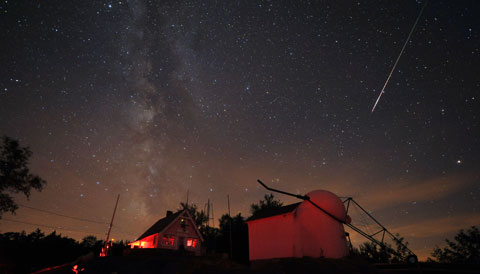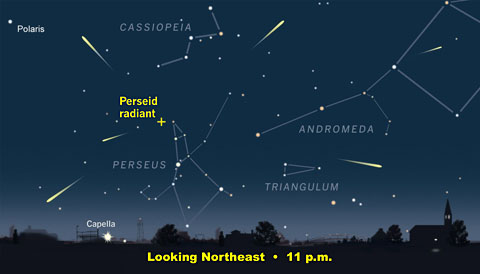Contacts:
Alan MacRobert, Senior Editor, Sky & Telescope
855-638-5388 x22151, [email protected]
Kelly Beatty, Senior Editor, Sky & Telescope
855-638-5388 x22168, [email protected]
| Note to Editors/Producers: This release is accompanied by publication-quality illustrations and a video animation; details in the captions below. |
The Perseid meteor shower, an annual celestial event beloved by millions of skywatchers around the world, returns to the night sky this week. And because the Moon will be just about new, no bright moonlight will hinder the view.

Sky & Telescope / Dennis di Cicco
Sky & Telescope magazine predicts that, for North Americans, the Perseid shower will be at or near its peak late on Wednesday night (late on August 12th and early morning on the 13th). You can also see some Perseids, though fewer in number, for several nights before and after that date.
"The nearly moonless sky this year means the viewing will be excellent," notes Alan MacRobert, a senior editor at Sky & Telescope.
Although an occasional Perseid meteor might catch your attention shortly after evening twilight ends, the prime viewing hours are from about 11 p.m. or midnight (local time) until the first light of dawn. This is when the shower's “radiant,” its perspective point of origin, is high up in your sky. The higher the radiant, the more meteors appear all over the sky.
To enjoy the Perseids, you need no equipment but your eyes. Find a dark spot with a wide-open view overhead. Bring a reclining lawn chair or a ground cloth so you can lie back and watch the sky in comfort. Bundle up in blankets or a sleeping bag, both for mosquito shielding and for warmth; clear nights can grow surprisingly chilly under the open stars (due to radiational cooling). “Relax, be patient, and let your eyes adapt to the dark,” says Senior Editor J. Kelly Beatty. “With a little luck you'll see a ‘shooting star’ every minute or so on average.”
Perseids can appear anywhere and everywhere in the sky. So the best direction to watch is wherever your sky is darkest, usually straight up. Faint Perseids appear as tiny, quick streaks. Occasional brighter ones may sail across the heavens for several seconds and leave a brief train of glowing smoke.

Sky & Telescope illustration
The Perseid meteors appear to stream away from the shower's "radiant" point near the border of Perseus and Cassiopeia. This is the perspective point where they would all appear to be coming from if you could see them approaching in the far distance. In fact we see them only in the last second or two as they streak into Earth's upper atmosphere, and this can happen anywhere in your sky.
Under dark-sky conditions, you may see an average of one a minute around the time of the shower's peak. You're very unlikely to see several at once!
When you see a meteor, track its path backward. If you eventually come to the constellation Perseus — which climbs the northeastern sky as the night progresses, as seen above — then a Perseid is what you’ve just witnessed.
The higher the radiant, the more meteors you'll see. But when the shower’s radiant is still low above the horizon, the few Perseids that do appear will be spectacularly long "Earthgrazers" skimming far across the sky along the top of the atmosphere.
Occasionally you might spot an interloper. The weaker Delta Aquariid and Kappa Cygnid showers are also active during Perseid season, and there are always a few random, “sporadic” meteors. All of these track back to other parts of the sky.
Any light pollution will cut down the numbers visible. But the brightest few meteors shine right through light pollution. In fact, a recent NASA analysis of all-sky images taken from 2008 to 2013 shows that the Perseids deliver more bright meteors (those that outshine any star) than any other annual meteor shower.
How and Why
Meteors are caused by tiny, sandgrain- to pea-size bits of dusty debris streaking into the top of Earth's atmosphere roughly 80 miles up. Each Perseid particle zips in at 37 miles (60 km) per second, creating a quick, white-hot streak of superheated air. The nuggets in Grape Nuts cereal are a close match to the estimated size, color, and texture of typical meteor-shower particles.
These particular bits were shed long ago by Comet Swift-Tuttle and are distributed all along the comet's orbit around the Sun. Earth passes through this tenuous "river of rubble" every year in mid-August.
For more skywatching information and astronomy news, visit SkyandTelescope.com or pick up Sky & Telescope, the essential magazine of astronomy since 1941.
For skywatching information and astronomy news, visit SkyandTelescope.com or pick up Sky & Telescope, the essential guide to astronomy, with subscribers in more than 100 nations. Sky & Telescope and SkyandTelescope.com are divisions of F+W, a content + ecommerce company. F+W also publishes SkyWatch (an annual guide to the night sky) as well as books, star atlases, posters, prints, globes, apps, and other fine astronomy products.
 0
0
Comments
You must be logged in to post a comment.